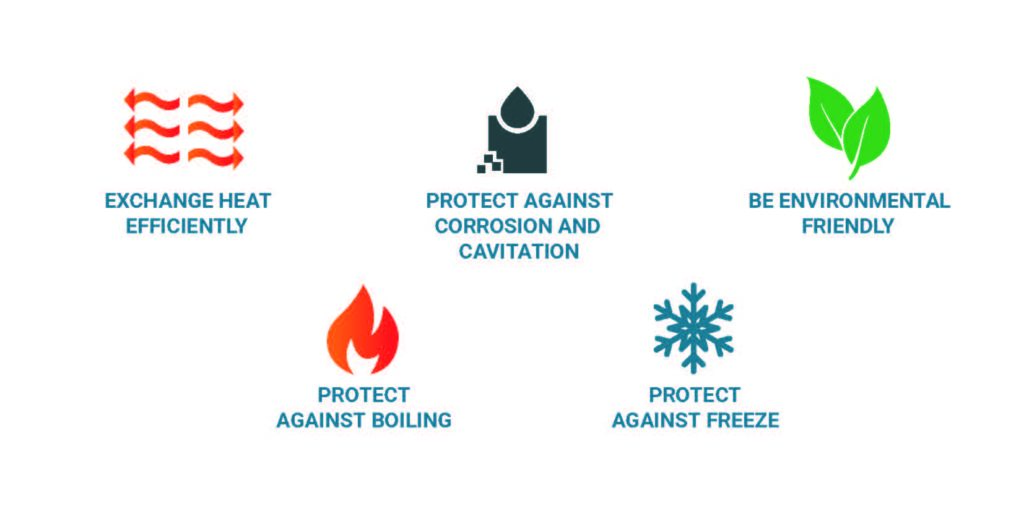
Choosing the Right Coolant – A vital task to ensure your fleet’s protection this winter
Fleet operators run busy schedules with very little room for mismanagement and errors to meet their customers’ high demands and ensure optimum efficiency. On top of this, they face everyday challenges in keeping the business running, including the regular maintenance and upkeep of their fleet. Unexpected downtime in the fleet is the last thing they need and can be very costly. Maintaining the fleet correctly and choosing the right lubricants, coolants, and fluids are very important to this maintenance.
With the onset of winter upon us, it now becomes even more crucial to ensure we are using the right coolant and are within the recommended coolant range. Coolants and antifreeze play an important role for your fleet all year round but become even more important during winter as they:
- Preventing freezing:Water is required to help prevent overheating, but water alone in the system would be at risk of freezing during cold weather. Coolant is a mixture of water and antifreeze, and one of its many functions is to lower the freezing point of water to prevent freezing, which would damage the coolant system and in turn, the engine.
- Preventing overheating: Coolant helps to prevent the engine from overheating. When the engine is running, it generates a lot of heat. Coolant circulates through the engine block and radiator to absorb and dissipate this heat into the air.
- Preventing corrosion: Coolant contains inhibitors that help to prevent corrosion of the engine’s internal components. Corrosion can damage these components and lead to expensive repairs.
- Minimising maintenance and downtime: Using the right coolant and maintaining the proper coolant level can help reduce the risk of winter-related engine problems. This, in turn, can save you from costly repairs and downtime during the colder months.

Now that we know how important coolant is for trucks and buses in winter, we must look at choosing the correct one for your fleet. Looking at the colours alone isn’t the right way to choose the ideal coolant and therefore, a lot more factors come into play here depending on the make, model, types of inhibitor packages being used in a coolant, etc.
The inhibitor package is only a small part of the coolant, but it has the strongest influence on the coolant quality. Only a few years ago, there were three main different types of inhibitor packages, whereas today, there 6 main packages used across the various coolants/antifreezes on the market with a wide variety of colours used to identify them.
- IAT (Inorganic Additive Technology (mineral)) – Silicates – Green or Blue
- OAT (Organic Acid Technology) – Organic Acids – Orange, Red or Yellow
- HOAT (Hybrid OAT, Phosphate-free) – NAP-free – Turquoise
- HOAT (Hybrid OAT) – Silicates and organic acids – Yellow
- Si-OAT (Silicated HOAT) – Silicates and organic acids – Purple or Pink
- P-HOAT (Phosphated HOAT) – Phosphates and organic acids – Blue or Pink
As you can see from this list, there is some crossover in the colours used between various coolant kinds, and this list is merely an illustration of the most popular colours used by the leading manufacturers. Since many coolants are incompatible with one another, selecting the incorrect coolant or mixing different coolant types can have expensive repercussions. Mixing coolant types with different additives can dilute or affect the additive properties, thus lessening the impact and protection given or indeed cause a reaction to create a mixture which will block up the system. For fleet and bus operators, especially operating mixed fleet, standard IAT coolant/antifreeze would be suitable for older vehicles, SI-OAT coolant/antifreeze for most fresher vehicles (Scania, Mercedes, MAN). And for the latest Renault & Volvo, they have a new requirement for the new OAT coolants/antifreeze with RTCS-2 & VCS 2 specifications, which is orange/light red in colour.
If you are still unsure of the correct product type to use, here are some points to keep in mind:
- Refer to the vehicle’s manual to see which type of coolant/antifreeze should be used to ensure you stay within the vehicle’s warranty.
- All too often, people can be persuaded by price, especially cheaper universal products claiming to meet all vehicle requirements. This is no longer possible as specific manufacturers have specific requirements and formulations for their cooling systems. Hence, the need for 6 different types on the market.
- Check the colour and look for similar colours but remember colour should only be used as a guide, and you need to check the exact type of coolant on the label to ensure it matches what your manual indicates is the correct type.
- If unsure, always consult a trusted stockist/supplier for the correct guidance on which type, you require and the best brand to look for.
Finol has been advising & supplying customers with Coolants & Antifreezes for over 40 years and ensuring customers are using the right products. As a customer of Finol, as well as talking to our technical support, you can use our easy-to-use WhichOil app www.whichoil.ie for guidance. If you are not yet a customer of Finol and would like to talk to one of our sales & technical team, you can arrange a free consultation by contacting +353 (0)1 2238842 or fleet@finol.ie.

